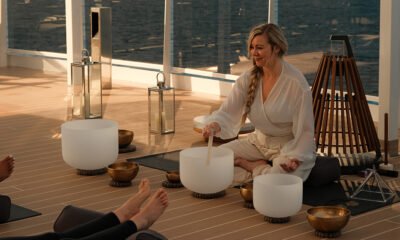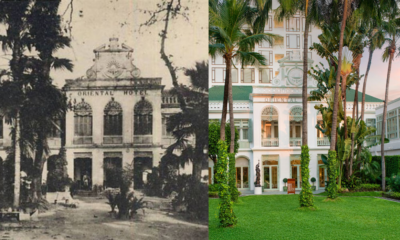Spiritual Travel
Six Senses Vana in Rishikesh Goes Right to the Spiritual Source
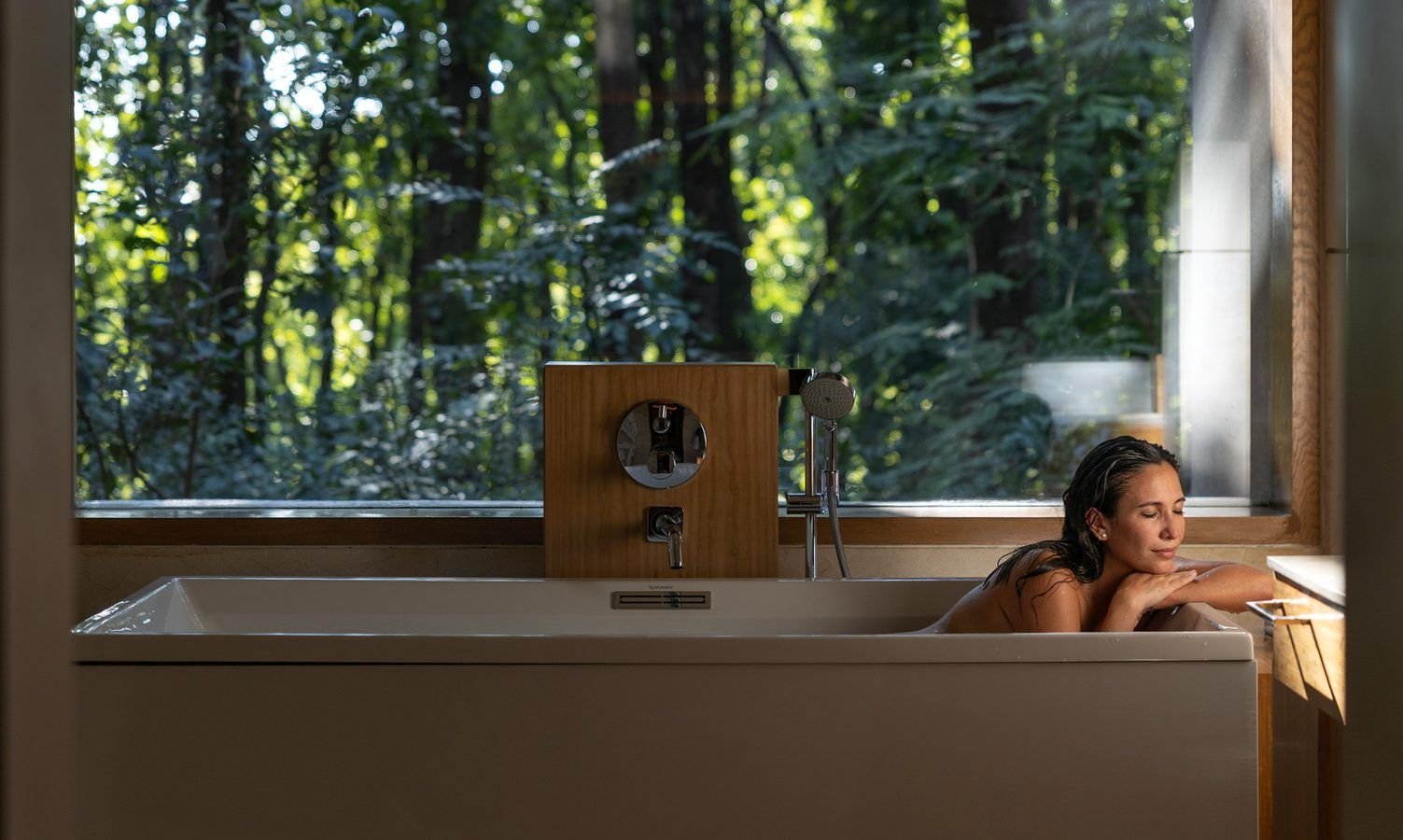
THE PLUSH LEATHER INTERIORS, fluffy pillows and cozy hand-woven woolen blankets of our pick-up at Delhi airport promise an exceptional experience. It is a five-hour drive to Dehradun, where Six Senses Vana is located, and thankfully the car was stocked with spiced nuts, homemade cookies and warm chai. This is lovely—enchanting ragas play as we pull out of the city and onto the highway. I recline into my chair and drift off, knowing that soon, I will be surrounded by nature.
Three-and-a-half hours in, I awaken to a steady whizz of the landscape. Rural, yes. Lush? hardly. Low-rise structures line the roads, the frontline to a mixed-use geography, a hodgepodge of industrial warehouses and factories, plots of sugarcane crops, and habitations of varying degrees of construction. There is no sign of the Himalayan serenity that I had in mind.
Eventually the driver shares that we are approaching Rishikesh, and then driving further past it, as I had a small glimpse of the famed Ganges and a few ashrams before snaking through dense streets once more. A nervous flutter appears in my belly; I was expecting some kind of special experience with spiritual encounters and nature, but we just passed an H&M and Starbucks.
“We’re here!” exclaims our driver cheerily. Baffled, but with and open mind, I turn toward a large gate surrounded by tall bamboo. We are greeted at the welcome center and laugh as the receptionist takes our photos—haggard and tired. “This is to compare with your photo when you leave the resort,” she shares before leading us to a waiting buggy.
The cart slowly snakes down a cobblestone path, melting into more and more greenery as the soundscape of the bustling city gives way to rustling leaves and birdsong. How is this possible? I ask myself. I swear we saw Uniqlo a few moments ago. This feels otherworldly, like I’ve crossed an invisible forcefield and entered a vortex of wellbeing. This is Six Senses Vana.
Dedicated Wellness
Located about an hour northwest of Rishikesh, the yoga capital of the world, is a sprawling 21-acre property that locals fondly call Vana. Named after the Sanskrit word for forest, the resort is surrounded Sal trees and lush vegetation. Founded in 2014 by Veer Singh, a trailblazer in the luxury wellness industry, the property is designed to bring people closer to nature, to each other, and to themselves.
This is no ordinary holiday; this retreat center takes its job seriously. That job? To send you home better than when you arrived. With minimum stays of three nights, the resort attracts guests on 10-day (or longer) programs with varying objectives. Although they offer a variety of practices and methods like Ayurveda and Natural Therapies, I decided to focus on Sowa Rigpa, traditional Tibetan medicine, helmed by Dr. Tenzin Sopa.
Every guest begins by donning white kurtas, a symbol of leaving behind the outside world, before consulting with an intake specialist for a combination of biometrics and traditional pulse readings. Dr. Sopa shares with me that in Tibetan medicine there are two energies in the body: rangshin and nyepa. “Rangshin is your essence,” he explains. “It is what you are born with, it is your soul and life-force energy. There is male and female, not necessarily related to your gender. And there is a third rare energy: boddhisatva. Nyepa is your current energy; what is happening in your body right now.” Nyepa is comprised of three main energies: loong (wind), tripa (fire) and badkan (water).
After declaring I had too much fire in me (I always knew I was a bit spicy) I am put on a regimen of balancing treatments and dietary recommendations which includes avoiding anything too fermented and imbibing personalized concoctions of green juice for breakfast and herbal infusions for after dinner. The food at Vana is exceptional, which makes eating healthy a dream. Nourishing meals are made from the freshest harvest and crafted with global flavor. I lean into the bold spices of the local fare and had my fill of dosa and coconut sambar for breakfast, vibrant zesty salads and hearty curries for lunch, and comforting silky vegetable soups and mung dal kitchari for dinner. The international fare is also creative and delicious: think sweet potato gnocchi or beetroot ravioli.
The Six Senses Vana’s Sowa Rigpa center is dedicated your holistic wellbeing journey. Ku-nye is a centuries-old, oil massage practice that makes use of specific pressure points, combining it with dhug, herbal compresses, and entrancing mantra to balance the energy flow in the body. I was treated to a four-hand experience, with two therapists working their healing magic on me. The combination of their melodic chanting and rhythmic movement lulled me to a dreamlike state of total relaxation. This is followed by an herbal steam. I am placed in a wooden box and covered in towels with only my head exposed. I feel a little bit like a dim-sum bun but happily ease into the session, closing my eyes in blissful surrender.
Apart from other prescribed Sowa Rigpa treatments, I indulge in the most incredible acupuncture and cupping sessions with Dr. Shreyas, a jolly man with a big laugh and even bigger stories—which come in handy to distract you from the needle placements. I learn that he spent six months stuck on a cruise ship during the pandemic. “It was an incredible time,” he shares. “It was the only time I really felt so untethered and really hit my lowest points, but it was also filled with moments of joy, beauty and shared humanity.” He recounts dreamy nights of endless starry skies, filled with the sound of acoustic music. “I had so many Filipino friends—they always loved to sing and dance. They always found the happiness.” He managed to make it back to India thanks to the good graces of a mysterious Saudi prince who purchased the cruise line and made it his mission to get every crew member home. “I am amazed at his generosity and how people just banded together to help each other.”
I am completely moved by his story, and before I know it, he has placed myriad needles on my back including some very long scary ones on my glutes, as well as several ventosa cups that are weirdly painful yet pleasant. In Filipino we’d call this “sarap sakit” or “hurts so good.”
Although I was intending to make this trip about deepening my spiritual practice, I decided to succumb to physical approach to healing that was being offered to me. My body is a temple after all, and the last few hectic months have left it a neglected, dusty, creaky mess.
Rhythm and Ritual
The cool winter air nips at my ears, the sky is clear, and the moon is bright and full, slowly creeping its way beyond the treetops. A raging fire burns on the open deck in front of Vana’s library. The pyre is as high as my shoulders and its flames flash blinding sparks as we toss peanut candies into its core. I’ve done my seven rounds of striding intentionally around the pit. The drums pound, loud and rhythmic, almost painful to the ears if you meet the percussion with resistance. I allowed it to snake through my ear canals and take hold of my body. Tears stream down my cheeks. As much as I try, despite the crowd of guests watching from the sidelines, I can’t hold them back. I just let them flow. My mouth is set in a big smile, the salty liquid pooling at the corners of my lips. And I dance. I dance like no tomorrow. Like time doesn’t exist. Like a mad woman, wild and free.
The festival of Lowri in Northern India celebrates the last of the coldest days of winter, the welcoming of warmth and the slow return of the sun. Gradually a handful of other brave souls approach the fire to dance and together we gyrate like the licks of flames, arms raised up toward the heavens. An older lady with a beautiful face and gray hair takes charge. She holds my hand and without words choreographs a sprightly ballet. We are women locked together in solidarity as bringers of life, pure shakti. I knew in my heart that this, too, is the end of my darkest days. I leave behind a period of challenges and shadow work and finally enter a season of light, an embracing of joy.
This is the power of ritual. It moves, it transforms, and it transcends. The question is: why have we forgotten it? Where has the sacred gone?
Natural Medicine
Between Six Senses Vana’s Zen-like atmosphere and plush beddings of our room and the expertly curated serene enclaves that dot the property, by the third day I am feeling refreshed and rejuvenated. Just an hour drive from Vana is Jabarkhet Nature Reserve, one of the many hikes and trails that surround the resort. Our guide, Deepak, is a chatty young man with spectacles who used to be one of the rangers of Jabarkhet. A native of Mussoorie, he’s so passionate about the environment. “The Himalaya is special,” he muses. “It is the birthplace of the Ganga. There is so much beauty and peace here.”
The crisp winter morning air makes the short but steep climb fairly easy. Cold Himalayan winds sweep across the foothills, gently warmed by the valley sun, and kisses our faces with grace. The landscape is exhilarating. It is my first time to ever see the Himalayas so close. Framed by tattered prayer flags, worn thin and faded, dispersing the ephemeral well wishes with every gust, distant angular snow-capped peaks looked like sculptural pedestals from which mortals hope to catch a glimpse of the heavens.
“I’ve climbed those five peaks,” says Deepak. “We trekked across the valley, through the villages, stayed in camps across the ridge. It was one of my most special experiences.”
There’s a yearning in my heart to one day scale this revered range, but for now I bask in awe, allowing the pure glacial prana to fill my lungs and clear away the shadows. We sit quietly and sip our chai, tears well up in my eyes, the healing power of nature never ceases to amaze me.
Sacred Chaos
A visit to Rishikesh is de rigueur. Frankly, based on our drives-by, I am skeptical. It’s a busy town, with ongoing construction everywhere, lots of low-rise buildings squished together filled with shops peddling mala beads and yoga mats, tour operators offering rafting tours and hand-painted signs hanging askew that promise “yoga and meditation.” It’s not what I envisioned the birthplace of yoga to be. Apart from the meandering cows, of course. That lived up to my expectations.
As we move through the streets, I realize how Western my view of spirituality is. My mind has been so polluted by what luxury wellness travel depicts as “peace” that for a brief moment, I had failed to see that amidst the chaos was joy. An unmistakable lightness permeates the atmosphere. “Shiva Shambho” plays loudly on repeat, from where? Who knows. Instinctively I sing along, calling upon the softness of the deity, Shiva in its most auspicious form.
Shambho, the source of bliss. Couples walk hand in hand across the bridges, taking photos against a saffron sky. Families triumphantly soaked by the rapids of the Ganges hop off their rafts in cheerful camaraderie. Captivating babas wizened with time and prayer meander with purpose. At every corner, a ritual, a temple, an offering. Young children are blessed by the holy waters while across the river, a funeral pyre is ablaze. Life, death, and rebirth endure. The golden light of the late afternoon is made misty by incense smoke, a holy haze envelopes this place. The sacred is alive and is everywhere.
As the night slowly creeps in, the temperature drops, the banks of the city glow with intensity and the entrancing melodies of kirtan begin. Aarti is performed nightly, butter lamps or diya, are set aflame and offered in honor of Mother Ganga. While Parmarth Niketan’s devotees flock in for their famed satsangs and prayers, Shatrughan Ghat offers quite a theatrical experience. Officiated by Shatrughana temple, the handsome and regal looking priests enchant pilgrims with a choreographed dance of fire, smoke and a shower of marigold petals. Ritika Trehan, our liaison from Six Senses Vana, whispers to me “they’re quite famous on Instagram!” Of course they are. I smile and laugh at the wonderful and shameless integration of the sacred and social media. Another example of ritual and reality beautifully co-existing.
A charming little girl with striking light-brown eyes tries to sell me some flowers for offerings. I had seen her several times earlier in the day. I had given her some fruit. An orange and some bananas instead of the cash she had hoped for. Unfortunately, the convenience of technology meant my pockets were always empty. This time her little brother is with her. He laughs and smiles at me and hands me a flower. “For you,” he says. I cry. A recurring theme throughout my trip. His sister also decides she wants to give them to me. I graciously accept, deeply touched by their generosity.
Good Vibrations
“I feel every day, every moment, new positive vibrations,” shares Manoj Dwivedi, mahant or chief priest of Shatrughana temple. The man has a noble face and sparkling eyes. His presence is quite a beacon, with no airs or pretense, he patiently and eagerly answers all my questions with a smile. Does he have any advice to people? “Please do service for the society,” he emphasizes. “Many forget to give back. People are so busy, but they don’t even really know why they are busy,” he says with a chuckle. “Service gives purpose and meaning.”
Dwivedi comes from a long line of priests and is proud of his heritage. He shares with me that he and his wife travel often, invited from around the world by devotees of the temple. He is about to embark on a trip to Hungary and expresses that one of his favorite places is Assisi. “It’s where Saint Francis was from, he’s a very wise and holy man. The spiritual energy there is very strong.”
I reflect on the openness of this statement. How wonderful it was that he embraced other forms of spirituality so freely, without judgment. Was this perhaps the result of polytheism? An inherent tolerance and acceptance of all? How beautiful. Imagine if the world had more of this and less of trying to prove who is right.
“The only problem with traveling for me is that when I go anywhere, I am immediately homesick,” he says. “You miss her. Mother Ganges is our life.” I can understand this. Earlier that day, further upstream from the city, I spent some precious time on the banks of the river. I marveled at its ice-blue waters, rushing past smooth stones, carrying its good grace in the flow. It’s difficult to explain what I felt. A clarity? A lightness? The divinity that lives in everything? In me? In the sun? In the water? It’s cheesy but it’s also true.
These musings flash through my mind, and almost like he can read it, the Mahant says “There is a strong energy when I sit by her banks. A vibration that is inexplicable. It’s a force.” I just nod. “Is this your first time in Rishikesh?”
“Yes,” I reply.
“Once you have come to Rishikesh, it will always call you back home.”
He’s right, I’m already planning my return.
BOOK YOUR STAY AT SIX SENSES VANA VIA BOOKING.COM
Sixsenses.com; doubles begin at 1,100 USD ++ with a minimum stay of 3 nights
Note:
The information in this article is accurate as of the date of publication.
We may earn an affiliate commission when you shop through links on our site.
Written By
Spiritual Travel
Atul Patne, Maharashtra tourism principal secretary- The Week
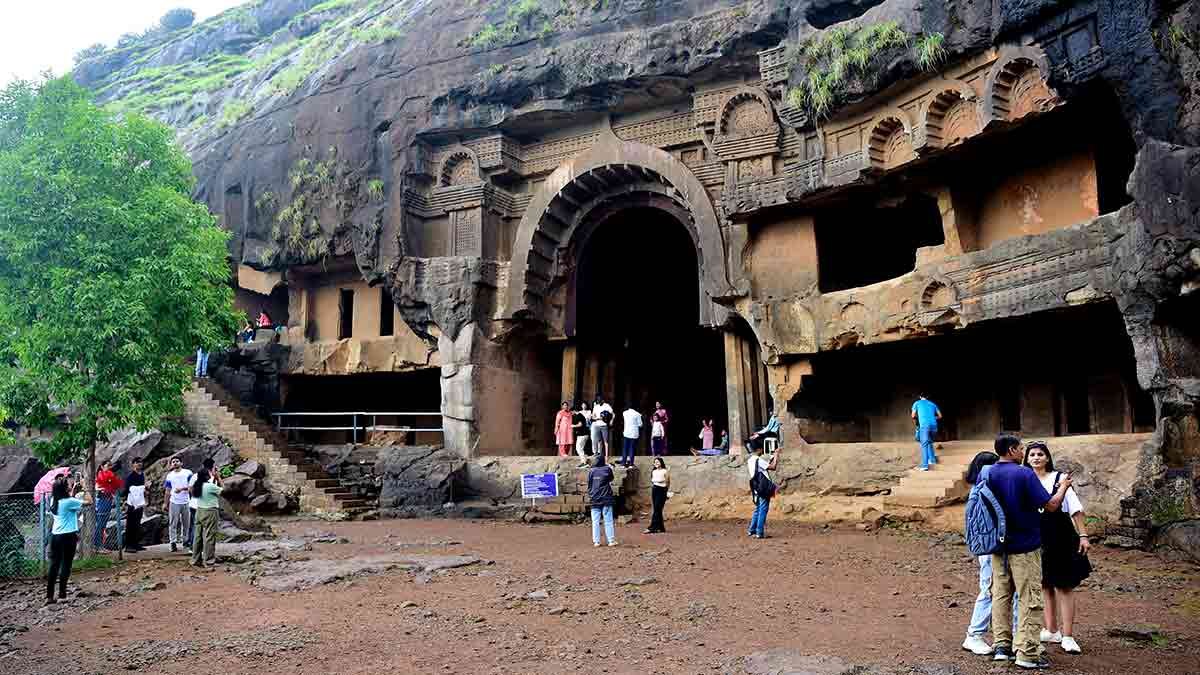
Interview/ Atul Patne, Principal secretary, tourism, Maharashtra
Maharashtra’s tourism potential is vast—ranging from beaches and heritage sites to wildlife reserves. In an interview, the state’s Principal secretary, tourism, Atul Patne, explains what makes his state a unique travel destination. Excerpts from an interview:
What is your strategy to position your state as a year-round destination?
Maharashtra is already a year-round destination. From beaches, heritage sites, and wildlife reserves to mountains, food, festivals, spirituality and adventure, Maharashtra truly has something for every traveller, every time of the year.
Unlike many northern states, Maharashtra enjoys a moderate climate. The monsoon season sees a significant influx of domestic tourists. From October to March, we witness strong international footfall. Even during the peak summer months of April and May, our beaches and coastal destinations remain popular.
How do you plan to promote lesser-known destinations like Lonar and Amboli?
Destinations like Lonar and Amboli are already gaining popularity, particularly among young travellers and special interest groups such as nature clubs, bird-watchers, photographers, cyclists, bikers, and road trip enthusiasts—largely thanks to social media. A special tourism circuit is being developed connecting Nashik, Nagpur, Chhatrapati Sambhajinagar, and Lonar, supported by enhanced rail and road connectivity.
How is Maharashtra aligning its tourism development goals with sustainability and environmental protection, especially in ecologically sensitive areas?
This is a topic very close to my heart. We are promoting responsible and sustainable tourism through policies that encourage homestays, bed-and-breakfast accommodations, and small hospitality ventures—especially those led by women under the AAI scheme.
Do you have plans to revamp branding and marketing outreach?
We have significantly stepped up our marketing efforts, focusing on young, adventure-seeking audiences. Our campaigns showcase Maharashtra’s rich history, forts, coastline, Sahyadris, spiritual sites and vibrant cuisine. Innovative initiatives include inviting global food experts to promote our cuisine and organising a walkathon during the centuries-old Pandharpur Wari pilgrimage. For business tourism, we have established the Maharashtra Convention Bureau to attract MICE events.
What role does rural and agro-tourism play in your vision for inclusive tourism development?
It is central to our sustainable tourism policy. Through the AAI scheme, we are enabling villages to become tourism hubs. A successful model has already been implemented in Chinchani near Solapur. These initiatives generate local employment, preserve rural traditions, and reduce migration of young people to cities.
Could you talk about upcoming infrastructure projects that aim to boost tourism?
Our tourism policies include incentives for large-scale projects like aquariums, island development, and theme parks. We are actively encouraging public-private partnerships under the Viksit Maharashtra 2047 vision. NRIs are also being invited to invest in their ancestral towns to aid local development and tourism infrastructure.
Are there dedicated efforts to revive heritage tourism with guided storytelling, digital experiences, or festivals?
Forts are the pride of Maharashtra, and we are working closely with the ASI to take over select sites for development. Plans include experience centres, museums, immersive AI domes, and festivals that celebrate our forts, food and cultural heritage.
What are you doing to improve tourist experience, especially in popular but crowded spots like Lonavala or Shirdi?
We are focusing on behavioural change through clear signages, awareness campaigns and messaging to encourage responsible travel. Fines and regulations are being strengthened. At the same time, we are working on deploying a tourism security force and are conducting safety audits—especially for adventure operators. We want to bring about the change in the mindset of the crowd and that is a daunting task, but we will get there.
Ultimately, both tourists and authorities must share the responsibility to maintain these destinations. As for safety, we are setting SOPs for adventure tour operators, ensuring safety audits, deploying tourist police. These are some of the plans in the pipeline.
What is your vision for Maharashtra in the next five years?
Our goal is to make Maharashtra the number one tourism destination in India. We aim to do this through a model that is sustainable, inclusive, humanitarian and community-driven.
Spiritual Travel
Sobhita Dhulipala visits Velankanni Church and Nagore Dargah during spiritual trip to Tamil Nadu – Watch |
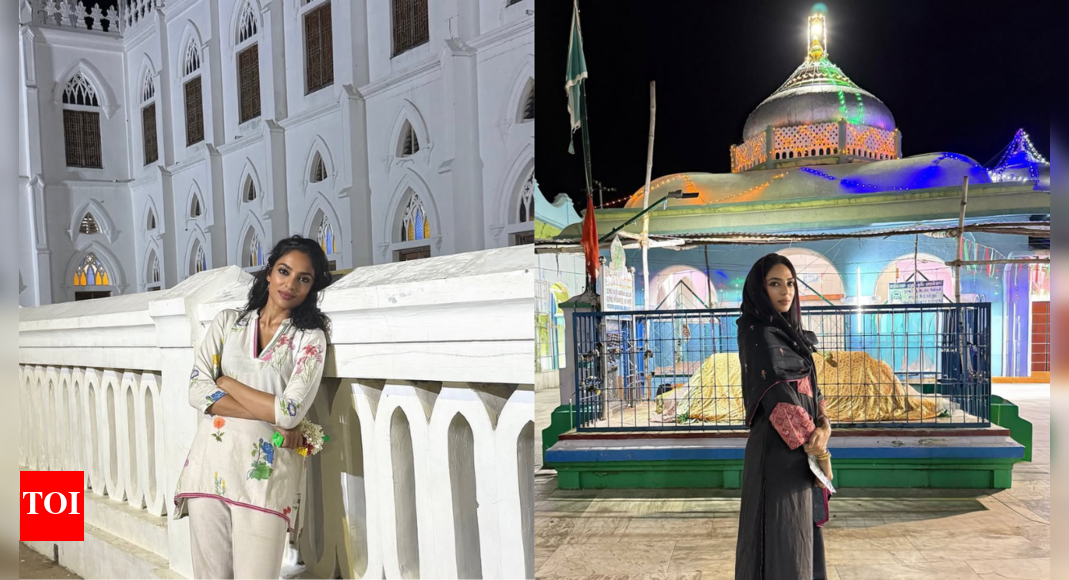
Actor Sobhita Dhulipala recently shared some pictures of her spiritual getaway in Tamil Nadu. The ‘Made in Heaven’ star took to Instagram on Thursday to share glimpses from her serene trip, which included visits to the iconic Velankanni Church and Nagore Dargah.
At Velankanni Church and Nagore Dargah
The actor shared photographs of her travels in her post with the title of “Life lately.” In these images, Sobhita was seen in a white outfit praying at the Velankanni Church, known formally as “The Basilica of Our Lady of Good Health”. The church is one of India’s most frequented Catholic shrines.Sobhita also visited the Nagore Dargah, a prominent Sufi shrine in Tamil Nadu located in the coastal town of Nagore. For this visit, she wore a black outfit, which complemented the modesty of the Dargah as well as fit with the overall spiritual tone of the site. The Dargah is the final resting place of the Sufi saint Nagore Syed Abdul Qadir Shahul Hamid.
Enjoying the beach
Sobhita also shared pictures of herself enjoying some peaceful moments at the beach as the waves washed over her feet. One photo shows her, with a calm expression on her face, relishing the sun and the joy of the moment. Another photo shows her feeling completely joyful alone. She also shared a photo looking beautiful in a gold saree from a friend’s wedding.On the work front, Sobhita was last seen in ‘Monkey Man’, Dev Patel’s directorial debut, which did not see a theatrical release in India. She also starred in ‘Love, Sitara’, but has remained quiet about her upcoming projects.Sobhita made headlines last year after she got married to Telugu star Nag Chaitanya after a long rumoured relationship.
Spiritual Travel
Jaljala holds potential for religious tourism but remains neglected « Khabarhub
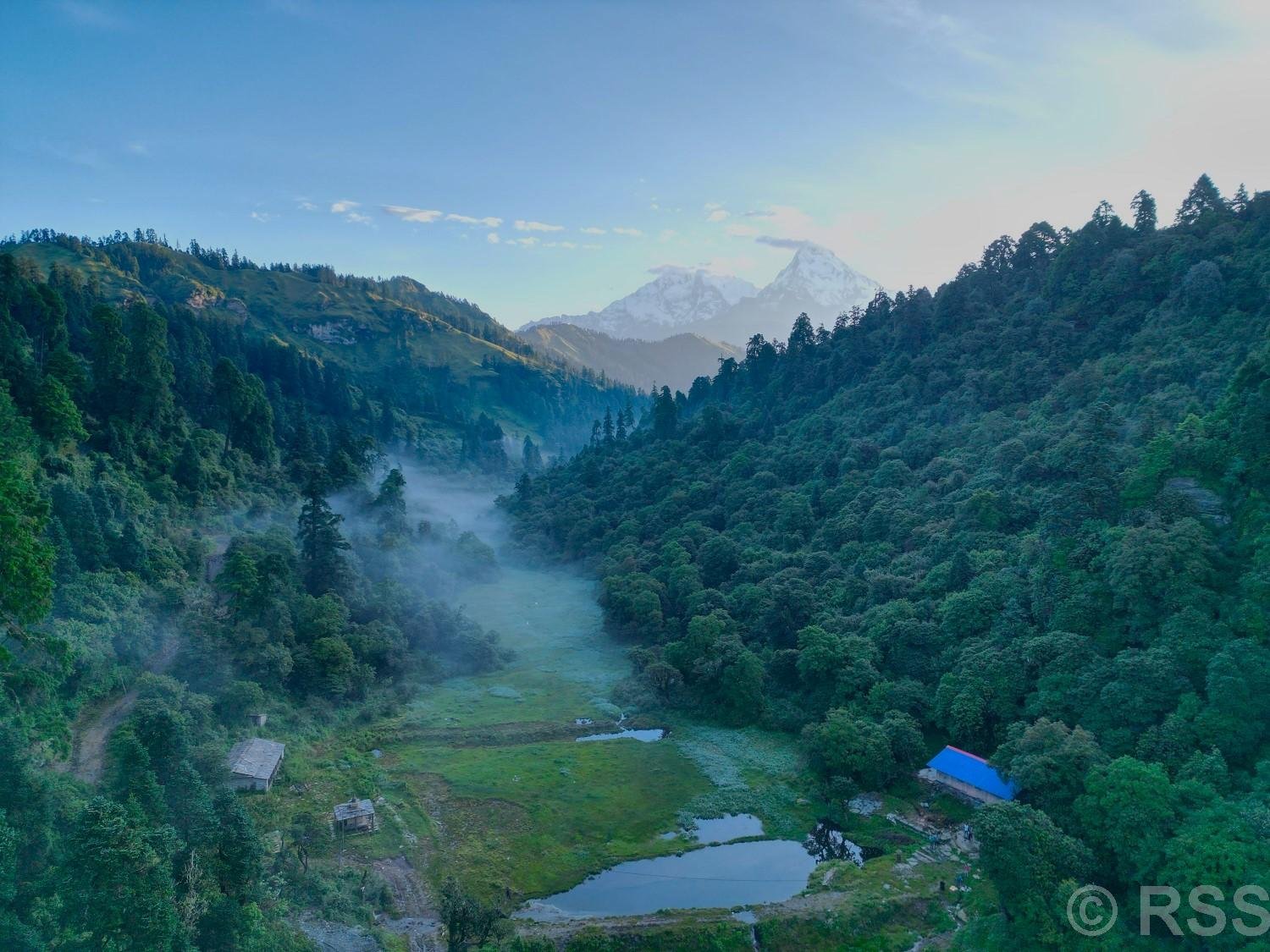
Jaljala area in Myagdi/RSS
MYAGDI: Jaljala, located at the tri-junction of Myagdi, Parbat, and Kaski districts, holds significant religious and tourism potential but remains largely neglected due to lack of infrastructure and promotion.
The Jaljala area, spanning Modi Rural Municipality in Parbat and Annapurna Rural Municipality in Myagdi, is referred to in Hindu scriptures as Hampal, Kalanjar, and Mrigasthali. Despite its religious importance, the area suffers from underdevelopment and poor accessibility.
According to cultural and heritage expert Prof. Dr. Jagannath Regmi, Hindu scriptures including Agni, Garuda, Kurma, Baraha, Skanda, Shivamaha, Padma, Brihannaradiya, Linga, Matsya Puranas, the Mahabharata, and the Shrimad Bhagavatam mention Hampal and Kalanjar.
“Despite being praised in sacred texts, Kalanjar—highlighted by Muktakantha in mythological literature—remains underdeveloped due to lack of publicity, remoteness, limited road access, and the absence of documented materials beyond oral traditions and natural and cultural sources,” said Regmi.
He noted that some ancient temples, shelters, and caves in the area are now at risk of disappearing due to a lack of protection. Religious texts claim that sages once performed penance in the Jaljala region, using its herbs for medicine, gaining spiritual insights, and offering Pinda (ancestral offerings) to attain salvation.
Tika Pun of Lespar, Modi Rural Municipality-4, who operates a small restaurant in Jaljala, said that due to limited awareness of the site’s religious and scenic value, tourist and pilgrim numbers remain low.
“Visitors mainly arrive during Mahayagyas held in autumn and spring. Otherwise, the place remains deserted,” he added.
Situated at an altitude of 3,300 meters, Jaljala features a gorge surrounded by breathtaking views of the Annapurna range. Just two decades ago, locals from Jaljala and Modi Rural Municipality used to graze cattle here during the monsoon, a practice that has since vanished.
From Jaljala, a 10-minute walk to Wi-Fi Hill offers views of Annapurna, while a 30-minute hike to Mateko Lake reveals panoramic views of Dhaulagiri, Annapurna, and Machhapuchhre.
According to Govinda Sharma, a visitor from Kushma, the scenic beauty of the region and surrounding settlements makes the challenging journey worthwhile.
Jaljala is also rich in biodiversity. Medicinal herbs such as bojo, satuwa, chiraito, amilo, brahmi (bholatapre), pashanbhed, jethimadhu, padamchalnu, niramasi, jatamasi, timmur, and siltimmur are found here. Wildlife sightings include deer along the banks and birds like vultures, cuckoos, and owls.
The region is accessible by trekking routes from Ghodepani, Pun Hill, Mohare Danda, Nagi (in Myagdi), and Modi Rural Municipality in Parbat. A dirt road connects Jaljala to Lekphant and Shalija in Jaljala Rural Municipality, according to Vice-Chairman Deepak Acharya.
“A grand yagya was organized to highlight Jaljala’s religious significance, and electricity has now been extended to the area,” Acharya said. “The federal government has allocated Rs 30 million for tourism infrastructure development here.” The Beni–Lekphant road has also been blacktopped recently, and further road upgrades have been requested.
-

 Brand Stories3 weeks ago
Brand Stories3 weeks agoBloom Hotels: A Modern Vision of Hospitality Redefining Travel
-

 Brand Stories2 weeks ago
Brand Stories2 weeks agoCheQin.ai sets a new standard for hotel booking with its AI capabilities: empowering travellers to bargain, choose the best, and book with clarity.
-

 Destinations & Things To Do3 weeks ago
Destinations & Things To Do3 weeks agoUntouched Destinations: Stunning Hidden Gems You Must Visit
-

 Destinations & Things To Do2 weeks ago
Destinations & Things To Do2 weeks agoThis Hidden Beach in India Glows at Night-But Only in One Secret Season
-

 AI in Travel3 weeks ago
AI in Travel3 weeks agoAI Travel Revolution: Must-Have Guide to the Best Experience
-

 Brand Stories1 month ago
Brand Stories1 month agoVoice AI Startup ElevenLabs Plans to Add Hubs Around the World
-

 Brand Stories4 weeks ago
Brand Stories4 weeks agoHow Elon Musk’s rogue Grok chatbot became a cautionary AI tale
-

 Brand Stories2 weeks ago
Brand Stories2 weeks agoContactless Hospitality: Why Remote Management Technology Is Key to Seamless Guest Experiences
-

 Asia Travel Pulse1 month ago
Asia Travel Pulse1 month agoLooking For Adventure In Asia? Here Are 7 Epic Destinations You Need To Experience At Least Once – Zee News
-

 AI in Travel1 month ago
AI in Travel1 month ago‘Will AI take my job?’ A trip to a Beijing fortune-telling bar to see what lies ahead | China

